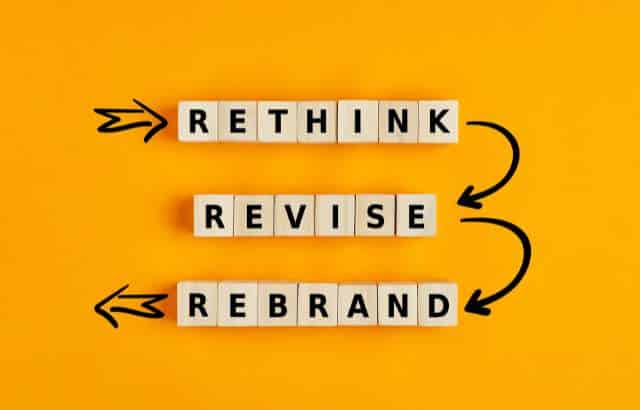In the ever-evolving world of business, staying fresh and relevant is a survival strategy. Rebranding, the magical makeover of a company’s identity, can breathe new life into a stagnating enterprise. Yet, the thought of rebranding often conjures visions of hefty expenditures and sleepless nights for business owners. But hold onto your wallets, because in this enchanting journey, we’ll uncover the secret of achieving a remarkable rebranding with minimal financial wizardry.
Table of Contents
The Art of Rebranding for Business Success
1. The Magic of DIY Design

Every great rebrand begins with a dazzling new logo. Instead of summoning expensive design sorcerers, consider unleashing your inner artist. There are numerous user-friendly design tools that will have you conjuring logos like a pro. With a touch of creativity and a pinch of patience, you can craft an emblem that speaks volumes about your brand.
2. Spellbinding Storytelling

Rebranding isn’t just about changing visuals; it’s a narrative transformation too. Crafting a compelling brand story can be done with the flick of a pen (or the tap of a keyboard). Your tale should resonate with your audience, evoking emotions and weaving a connection. Share it through your website, social media, and email marketing spells. Your story, not costly marketing spells, will be your most potent weapon.
3. DIY Website Wizardry

A bewitching website is essential, but it doesn’t need to drain your vault of gold. Tap into the power of website builders WordPress. These enchanting tools offer pre-designed templates that can be tailored to your brand’s essence. With a sprinkle of creativity and some time investment, your website will shine like a diamond.
4. The Magic of Collaboration

Networking with fellow sorcerers can be the most potent enchantment in your rebranding arsenal. Seek out partnerships, collaborations, or even barter arrangements. Exchange services, skills, or promotional spells with other businesses. Collaborations not only reduce costs but also expand your brand’s reach.
5. Harnessing the Power of Social Media Sorcery

Social media platforms are the cauldrons of modern marketing. They offer cost-effective ways to reach your audience. Create enchanting content, engage with your followers, and run targeted spells to boost your brand’s visibility. A little investment in paid advertising can go a long way in spreading your rebranded message.
6. Engage with Your Community
Don’t underestimate the power of engaging with your customers and community. Host events, webinars, or online gatherings. Engage in discussions, ask for feedback, and involve your audience in your rebranding journey. Their insights and support can be invaluable, and the price of admission is simply your time and attention.
7. DIY PR Potions
Public relations don’t require a magical budget. Write captivating press releases and distribute them through online platforms. Reach out to local influencers or bloggers who might be interested in your rebranding story. A little bit of charm and persistence can earn you media coverage without emptying your coffers.
FAQs: The Art of Rebranding – A Thrifty Transformation
1. What is rebranding?
Rebranding refers to the process of changing the image, design, and identity of an existing company, product, or service. It typically involves updating logos, color schemes, messaging, and sometimes even altering the company’s mission or values to better align with its evolving goals or target audience.
- Example: In 2010, Burberry rebranded to position itself as a luxury brand, shedding its outdated image of being “only for the older generation” and embracing youth culture, which led to a resurgence in popularity.
2. Why is rebranding important for a business?
Rebranding can help businesses adapt to market changes, reach new audiences, differentiate themselves from competitors, or refresh their image. It allows companies to stay relevant and maintain a strong connection with their audience.
- Stat: According to a 2021 survey by Siegel+Gale, 64% of consumers say that a brand’s personality is one of the most important factors influencing their buying decision.
3. What does a “thrifty” rebrand mean?
A “thrifty” rebrand focuses on achieving maximum impact with a minimal budget. This approach prioritizes strategic thinking, creative solutions, and effective execution over expensive redesigns or massive campaigns. It involves making smart choices that don’t sacrifice quality but still result in a fresh, updated look.
- Example: In 2016, Airbnb underwent a rebranding without breaking the bank. Instead of expensive advertisements, the company launched a user-generated campaign to highlight real experiences, which was much more cost-effective than traditional advertising.
4. How can a business successfully rebrand on a budget?
- Start with your core values: Rebranding isn’t just about design—it’s about communicating your mission clearly. Make sure the essence of your brand shines through.
- Leverage free and low-cost tools: Platforms like Canva, Adobe Spark, and social media can be great allies for updating visuals without hiring an expensive designer.
- Engage with your audience: Rebranding is also about reconnecting with your customers. Engage them through social media polls, feedback forms, or even contests to generate excitement without spending much.
- Quote: “A strong brand is not just about looking good, it’s about connecting with your audience on a deeper level.” — David Aaker, brand strategist
5. What are some signs that a company needs to rebrand?
- Lack of market differentiation: Your brand looks and feels like every other competitor.
- Target audience shift: If your brand isn’t appealing to the group you want to attract.
- Outdated visuals: If your logo or design elements are no longer reflective of modern trends.
- Poor customer perception: If customers associate negative traits with your brand.
6. How long does it take to rebrand a company?
The timeline can vary greatly depending on the complexity of the rebrand and the resources available. However, a basic rebrand can take anywhere from a few weeks to several months. A “thrifty” rebrand may be completed more quickly since it focuses on cost-effective strategies and quick execution.
- Example: Domino’s Pizza rebranded its logo and messaging within a short period in 2010 to distance itself from its previous image and focus on high-quality ingredients. This transformation happened relatively quickly and cost-effectively, yet it helped reverse the company’s declining sales.
7. What are the risks of rebranding?
- Alienating existing customers: If the new branding is too different from the old one, loyal customers may feel disconnected.
- Confusing your audience: If the rebrand doesn’t align with your target market, it can confuse or even turn them off.
- Over-promising: Rebranding can create high expectations that might not align with the actual changes.
8. Can rebranding increase sales?
Yes, when done correctly. A well-executed rebrand can reignite interest in your product or service, differentiate you from competitors, and build a stronger emotional connection with your audience, which can lead to increased sales.
- Stat: A study by Rebooting Your Brand in 2019 found that 48% of businesses who rebranded reported an increase in sales and brand awareness within the first year.
9. Should small businesses consider rebranding?
Absolutely! Small businesses may find that a fresh, more relevant brand helps them stand out and reach more customers. However, they should be strategic and focus on their unique value proposition. A thrifty rebrand could be a great solution to avoid overspending.
- Example: Cafe Gratitude, a small organic restaurant chain in California, went through a minimal yet impactful rebrand by simply focusing on more consistent messaging and modernizing their logo. This rebrand helped them capture a younger, health-conscious audience without hefty advertising costs.
Additional Insights:
- Case Study: The Thrifty Transformation of Old Spice: Old Spice’s 2010 rebrand is a perfect example of a cost-effective yet highly successful strategy. Instead of changing the entire product line or pouring millions into new packaging, they updated their marketing approach with quirky, memorable commercials. The campaign resulted in a 125% increase in sales.
- Stat: According to Forbes, 75% of brand recognition is based on how customers feel about the brand. That’s why emotional connection is so vital in a rebrand, even more than just the design or visuals.
Final Words
In conclusion, rebranding doesn’t have to be an expensive spectacle. By embracing the magic of creativity, collaboration, and DIY tools, you can perform a remarkable transformation with minimal financial impact. Remember, the most enchanting brands are those that authentically connect with their audience, and that magic doesn’t always come with a hefty price tag. So, don your wizard’s hat, gather your creative spells, and embark on your rebranding journey with confidence.















